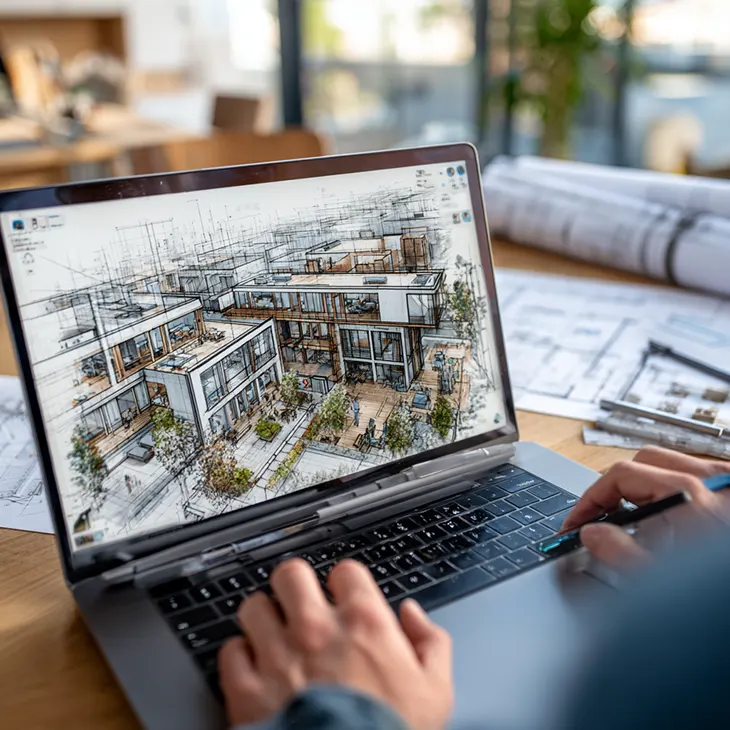
Construction projects are messy, time-sensitive, and full of moving parts, which makes coordination an ongoing challenge. That’s where virtual assistants come in. They don’t swing hammers or pour concrete, but they do keep schedules aligned, paperwork organized, and communication running smoothly. In short, they take on the tasks no one on-site has time for.
ARCHISCENE Editor In Chief Zarko Davinic is analysing the use of a virtual assistant on a construction site and beyond:
Handling documentation and administrative tasks
Construction projects come with a mountain of paperwork that no one’s really excited to deal with, but it all has to get done. An assistant can step in and manage those piles of contracts, permits, and inspection records that need organizing. Instead of spending an afternoon digging through old email chains for a file, the project manager can just ask the VA where it’s stored.
It’s not just about having things filed neatly. VAs can maintain a centralized digital workspace that’s searchable and up to date, whether that means keeping blueprints in order or ensuring the most recent version of an RFI is always available. It’s hard to overstate how much time gets wasted when people work off the wrong documents.
In addition to storage, a construction virtual assistant can also keep things flowing, tracking deadlines, reminding teams when permits need renewal, and even helping prepare payroll. None of these tasks is glamorous, but they’re what keep everything legally and financially on track. A good VA keeps the boring stuff from becoming a problem.
Instead of hiring another full-time admin, having a virtual assistant handle these jobs just makes more sense for many companies. You get the help you need without adding another body to the office or job site, which is ideal when your focus is on the field.
Streamlining communication between stakeholders
Construction sites thrive on coordination, but when everyone’s using different tools and working on separate schedules, things fall apart fast. That’s where a virtual assistant can step in and act like the communication glue holding everyone together. They can track who said what and when, and make sure everyone actually reads the updates they’re supposed to see.
It’s easy for messages to get lost between site supervisors, subcontractors, and clients. A VA helps by ensuring each party stays informed without creating unnecessary noise. They’ll follow up on pending questions, confirm meeting times, and give reminders that save people from showing up unprepared, or not at all.
They also manage tools most people don’t want to touch. One day it’s sending a bulk update through email, the next it’s managing a group chat or scheduling a video call for a site walkthrough. Whatever the format, the VA handles it so you don’t have to. It’s communication management with actual consistency behind it.
Instead of waiting on calls or chasing people down, construction teams can keep their focus where it belongs, on the build itself. The VA makes sure everyone’s aligned, reducing friction before it starts and stepping in when wires inevitably get crossed. What is clear, virtual assistants have a role far different from one a chat bot would have, even tho the two are often mixed up.

Assisting with procurement and inventory tracking
Ordering materials may seem simple until you realize that a single late shipment can delay an entire project. A virtual assistant can help construction teams stay ahead by tracking what’s been ordered, what’s arrived, and what still needs to be chased down before it becomes an issue. They do the follow-ups that get overlooked.
They’re also great at handling vendor coordination. Instead of having your foreman sit on hold to reorder the same nails for the third time, a VA can confirm quantities, compare pricing across vendors, and even arrange delivery logistics. It’s not glamorous, but it keeps the machine running smoothly.
VAs can help avoid those frustrating job site situations where everyone assumes someone else ordered the drywall. By tracking inventory levels across locations, they bring order to what’s often just chaos with spreadsheets. They create systems that help construction pros stop relying on memory and guesswork to manage supplies.
When construction timelines get tight, having someone in charge of making sure materials are where they need to be, before anyone notices they’re missing, makes a massive difference. And since VAs are remote, they do it all without getting in the way of on-site work.
Supporting scheduling and calendar management
Construction projects are filled with moving pieces, and even a minor calendar conflict can mess up an entire week and steer you away from a successful renovation. Virtual assistants can manage these calendars in the background, making sure that equipment rentals, contractor schedules, and permit inspections don’t overlap or get forgotten. It’s the kind of oversight that makes timelines actually work.
They’re not just filling out a Google Calendar, either. They understand dependencies, how one crew’s delay impacts the next. So, when something shifts (which it always does), they adjust the calendar, notify the affected teams, and ensure that new bookings occur without extra chaos.
There’s also value in how they streamline repetitive tasks. Booking inspections or coordinating shifts doesn’t need to involve three phone calls and a paper planner anymore. A VA can handle it quickly, confirm all the details, and make changes when needed, without letting anything fall through the cracks.
With multiple sites running at once, it’s easy for dates to get mixed up. Having a VA who stays on top of everything and sends reminders when deadlines approach gives project managers peace of mind. It’s one less thing to juggle in a job where there’s already too much to manage.
Helping with cost control and budget monitoring
Budgets can unravel quickly when no one’s watching the little stuff. A VA can help construction teams stay on top of costs by maintaining real-time tracking spreadsheets, logging purchases, and flagging anything that looks off. It’s about catching overspending before it becomes a problem that needs to be addressed later.
They also help compare vendor quotes and streamline those tiny financial decisions that tend to get pushed aside. Rather than waiting days to decide which supplier to use, the VA can gather options, list the pros and cons, and send a quick summary for approval.
It doesn’t stop at just monitoring spend. Virtual assistants can categorize receipts, enter line items into budget software, and even prep basic reports on the building site quotes. This provides project leads and accounting teams with a clearer picture of where the money is going, without requiring anyone to sit down with a calculator after hours.
Budgeting in construction isn’t just about the big numbers. It’s about thousands of small decisions, each with financial impact. A VA keeps those small choices organized and visible, giving project managers a tighter grip on overall costs; and more control over project profitability.
Wrap up
Virtual assistants won’t be found in hard hats, but their impact on construction coordination is real. From managing logistics to improving workflow, they free up teams to focus on the build. For companies looking to streamline operations without adding full-time staff, they’re an innovative and scalable solution.



